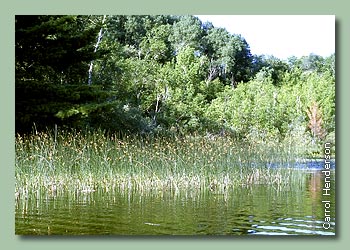| |
|
 |
Emergent bulrush marsh Bulrushes are tall slender plants with round stems and no leaves. They root in sandy or loamy soil at the bottom of the lake, sometimes at a depth of 5 or 6 feet. The upper portion of each plant stands above the water to a height of 3 to 6 feet, and produces flowers. The two most common species of bulrush are softstem bulrush (Scirpus validus) and hardstem bulrush (Scirpus acutus). They both occur essentially statewide, and sometimes grow side-by-side in the same lake. They can both spread underground and form dense stands. Bulrushes are very resilient, and are seldom uprooted by high waves. In fact, they absorb much of the energy of the waves, thereby protecting shorelines from erosion. They are eaten by a variety of aquatic wildlife, such as muskrats and geese, but they readily resprout. |
